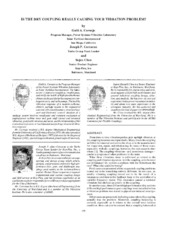| dc.description.abstract | From time to time vibration probes pick up high vibration at the coupling location on output shafts. Many times the coupling will then be removed and sent to the shop or to the manufacturer for inspection, repair, and rebalancing. In many of these cases, especially with dry couplings, however, the root cause is elsewhere [1]. The coupling vibration-and sometimes damage can be a symptom of other problems in the train. What these vibrations mean is addressed as related to the coupling and vibration signature. Is it the coupling, or is the rotor out of balance? Or, is there a problem with the fit between the two? What else could be wrong? Field cases are presented where suspected coupling problems turned out to be something entirely different. In one case, an axially vibrating coupling turned out to be the result of a resonance condition in the feedback loop in the controller of a variable frequency motor. This resonance caused a torsional vibration that showed up axially in the coupling. In another case, three different high performance disc and two different high performance gear couplings were installed before a vibration problem was traced to pipe strain induced misalignment. Other cases are presented, including some where the coupling actually was the problem. Moreover, coupling balancing is covered, especially as it relates to the overall rotor balance condition. How can you be assured that a coupling balanced at the factory will still be in balance when installed in the field? What is the importance of balancing tolerances and how significant are they when referenced to the out of balance due to fits and clearances? It is shown that the setup indication tolerances are a more significant contributor to overall coupling balance than actual balance machine unbalance tolerances. All of the cases presented involve dry couplings-ones that don't have lubricated gear teeth. On almost all new high performance turbomachinery applications, dry couplings have replaced the gear type, and one of the reasons for this is the general lack of coupling problems associated with the dry couplings (except for an occasional wind age problem). There are usually no wearing parts, and there are less clearances (like in gear tooth mesh), which can lead to significant unbalance and vibration in sensitive applications. | en |


